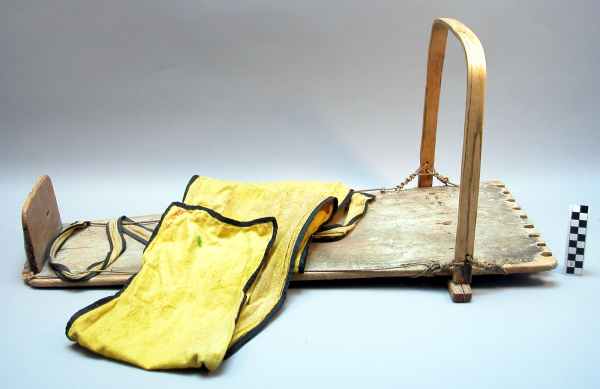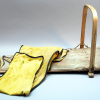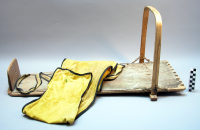káhrhon
káhrhon
káhrhon


Cradle board and wrappings. Backside carved and painted with floral and bird design. Footboard is attached with metal nails, while bow is attached with wooden pegs and nails. - The Peabody Museum of Archaeology and Ethnology. Additionally, both the fabric wrapping and the belt is trimmed with a black bias strip. Unlike the Ojibway tikinaagan and mossbag, the Haudenosaunee infant is wrapped and secured to the to the cradleboard with the belt and cordage. The crossbar is doubly secured to the backboard with cordage.
St. Regis Reservation
Family or a community member likely made the cradleboard.
Read More About This Relative
Wood, Cotton, and cordage.
The artist splits a tree into a plank using wedges and a mallet. The wooden strips are peeled from the log in a similar fashion. The wood strip is steamed or soaked in boiling water to make it pliable. The strip is secured to a form to hold the shape of the crossbar as it dries. The crossbar is fastened to the the backboard with nails or screws and sinew. The artist carves or paints designs onto the backboard. This cradleboard has a dentil feature along the top of the backboard. The mother and others create the wraps.
Traditionally, the cradleboard served multiple purposes. Its primary purpose was to safely carry the baby on the mother's back while she worked or moved from one camp to another. Both mother and baby would accompany each other while harvesting vegetables, berries and medicine. The baby was laced into the cradleboard under a protective covering. The covering protects the baby from the underbrush and insects. Its secondary purpose was childcare. The cradleboard was used to keep the baby near the mother and was usually placed against the trunk of a tree or hung from a branch. From this vantage point, the baby could watch the mother, the environment, social interactions and the animals. The cradleboard is constructed with a crash bar. This handlebar protects the baby from falls. A third benefit was how the cradleboard kept the baby's back and legs straight.
The Peabody Museum of Archaeology and Ethnology
The cradleboard protected the infant from tree branches, terrible weather conditions, sun rays, insects and non-human beings.
Provenance
Collector: Dr. Mark Raymond Harrington
Peabody Museum of Archaeology and Ethnology
About This GRASAC Record
May 30, 2021.







North America\United States\New York.
 Knowledge Sharing Platform
Knowledge Sharing Platform

